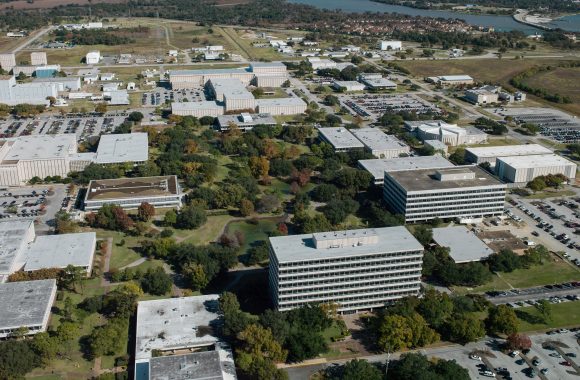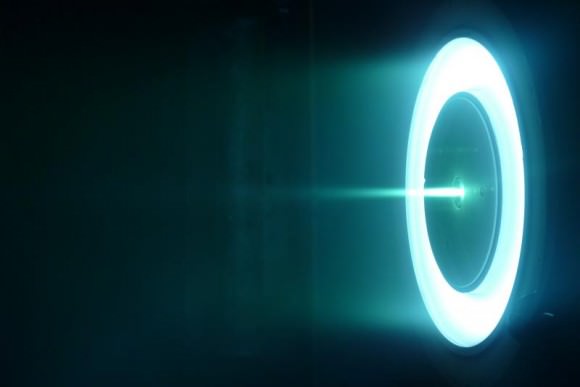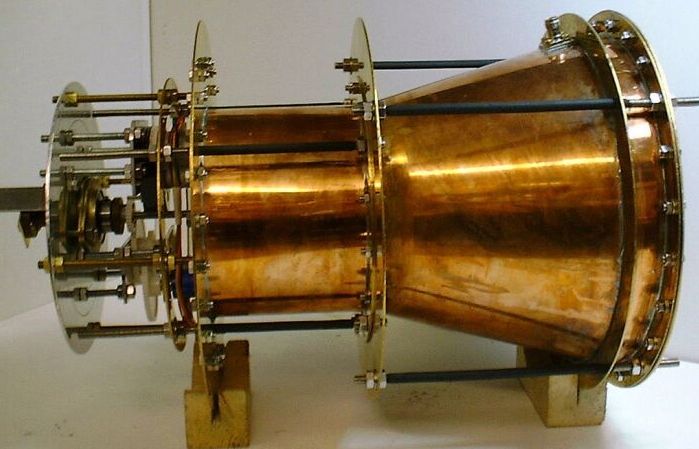Ever since NASA announced that they had created a prototype of the controversial Radio Frequency Resonant Cavity Thruster (aka. the EM Drive), any and all reported results have been the subject of controversy. And with most of the announcements taking the form of “leaks” and rumors, all reported developments have been naturally treated with skepticism.
And yet, the reports keep coming. The latest alleged results come from the Eagleworks Laboratories at the Johnson Space Center, where a “leaked” report revealed that the controversial drive is capable of generating thrust in a vacuum. Much like the critical peer-review process, whether or not the engine can pass muster in space has been a lingering issue for some time.
Given the advantages of the EM Drive, it is understandable that people want to see it work. Theoretically, these include the ability to generate enough thrust to fly to the Moon in just four hours, to Mars in 70 days, and to Pluto in 18 months, and the ability to do it all without the need for propellant. Unfortunately, the drive system is based on principles that violate the Conservation of Momentum law.

This law states that within a system, the amount of momentum remains constant and is neither created nor destroyed, but only changes through the action of forces. Since the EM Drive involves electromagnetic microwave cavities converting electrical energy directly into thrust, it has no reaction mass. It is therefore “impossible”, as far as conventional physics go.
The report, titled “Measurement of Impulsive Thrust from a Closed Radio Frequency Cavity in Vacuum“, was apparently leaked in early November. It’s lead author is predictably Harold White, the Advanced Propulsion Team Lead for the NASA Engineering Directorate and the Principal Investigator for NASA’s Eagleworks lab.
As he and his colleagues (allegedly) report in the paper, they completed an impulsive thrust test on a “tapered RF test article”. This consisted of a forward and reverse thrust phase, a low thrust pendulum, and three thrust tests at power levels of 40, 60 and 80 watts. As they stated in the report:
“It is shown here that a dielectrically loaded tapered RF test article excited in the TM212 mode at 1,937 MHz is capable of consistently generating force at a thrust level of 1.2 ± 0.1 mN/kW with the force directed to the narrow end under vacuum conditions.”

To be clear, this level of thrust to power – 1.2. millinewtons per kilowatt – is quite insignificant. In fact, the paper goes on to place these results in context, comparing them to ion thrusters and laser sail proposals:
“The current state of the art thrust to power for a Hall thruster is on the order of 60 mN/kW. This is an order of magnitude higher than the test article evaluated during the course of this vacuum campaign… The 1.2 mN/kW performance parameter is two orders of magnitude higher than other forms of ‘zero propellant’ propulsion such as light sails, laser propulsion and photon rockets having thrust to power levels in the 3.33-6.67 [micronewton]/kW (or 0.0033 – 0.0067 mN/kW) range.”
Currently, ion engines are considered the most fuel-efficient form of propulsion. However, they are notoriously slow compared to conventional, solid-propellant thrusters. To offer some perspective, NASA’s Dawn mission relied on a xenon-ion engine that had a thrust to power generation of 90 millinewtons per kilowatt. Using this technology, it took the probe almost four years to travel from Earth to the asteroid Vesta.
The concept of direct-energy (aka. laser sails), by contrast, requires very little thrust since it involves wafer-sized craft – tiny probes which weight about a gram and carry all their instruments they need in the form of chips. This concept is currently being explored for the sake of making the journey to neighboring planets and star systems within our own lifetimes.
Two good examples are the NASA-funded DEEP-IN interstellar concept that is being developed at UCSB, which attempts to use lasers to power a craft up to 0.25 the speed of light. Meanwhile, Project Starshot (part of Breakthrough Initiatives) is developing a craft which they claim will reach speeds of 20% the speed of light, and thus be able to make the trip to Alpha Centauri in 20 years.
Compared to these proposals, the EM Drive can still boast the fact that it does not require any propellant or an external power source. But based on these test results, the amount of power that would be needed to generate a significant amount of thrust would make it impractical. However, one should keep in mind that this low power test was designed to see if any thrust detected could be attributed to anomalies (none of which were detected).
The report also acknowledges that further testing will be necessary to rule out other possible causes, such as center of gravity (CG) shifts and thermal expansion. And if outside causes can again be ruled out, future tests will no doubt attempt to maximize performance to see just how much thrust the EM Drive is capable of generating.
But of course, this is all assuming that the “leaked” paper is genuine. Until NASA can confirm that these results are indeed real, the EM Drive will be stuck in controversy limbo. And while we’re waiting, check out this descriptive video by astronomer Scott Manley from the Armagh Observatory:
Further Reading: Science Alert


People do NOT accept change. The EM Drive is change. The thrust is not the traditional thrust people see from more traditional propulsion systems. The advantage is that if we want to move a planet, with enough energy, we can use the EM Drive. Imagine pushing our planet further out in orbit around the Sun when the Sun starts to expand into it’s Red Giant stage. Or as technology advances and energy becomes easily loadable onto a rocket, the EM Drive could reach relativistic speeds and push our rockets to the distant stars in a fraction of a human lifetime. Thus, making it possible for humans to travel to the stars without needing generational ships.
Correct me if I am wrong, but if we used that type of drive to get to relativistic speeds, we would also have to slow down. Wouldn’t that mean reversing thrust halfway through the trip which would negate much of the gains in travel time?
imagine only going 1 mm per second faster than keep your speed steady for the duration of the trip and than at the end slow down 1 mm per second.
for every year traveled, you’ld gain about 31.5 × 10^6 mm.
imagine the above for 2 mm/s
and for 3 mm/s
and for 4 mm/s
…. notice how intuitively you could understand that you keep increasing the speed to midway?
In this instance I wouldn’t say it’s a matter of people not liking change (although that is certainly a thing), but rather this is something that appears to fly in the face of incredibly-well-established physical principles. It only makes sense to rule out any possible ‘normal’ sources of thrust before accepting it as an example of new physics.
Not that I don’t want this to be real, because propellantless drive would be pretty darn awesome. 🙂
Your quote: “…a dialectically loaded ” is incorrect. It is “dielectrically…”
I almost laughed. 🙂 UT should assign Matt Williams a proof reader to catch the most glaring errors he makes! I don’t mind typos or other trivial errors, but when the scientific facts go wrong.. that’s BAD!!
And to anyone wondering, the quoted paper correctly spells “dielectrically”.
Perhaps it is loaded by argumentative Marxists.
What’s violated is our present understanding of how Nature works. Assuming the observations are real, what it means is that we have more to learn – but that’s always true, even in Physics.
For comparison, suppose there was some material, unobtainium, that had negative inertia. Then it would be understandable how a drive could achieve forward momentum while keeping the reaction material contained inside. It could internally push on the unobtainium. Then the positive forward momentum of the craft would be balanced by the momentum of the unobtainium, which would be negative even though it is moving in the same forward direction as the spacecraft.
As an analogy, a spacecraft can achieve non-zero angular momentum by rotating a flywheel enclosed within the spacecraft in the opposite direction.
This makes me wonder if the bouncing microwave beam is somehow behaving similarly to an object with negative inertia. The system has two microwave beams that are propagating in opposite directions. MIcrowave photons can carry momentum. Is it possible the backwards beam could acquire more momentum than the forwards beam? If so, then the net negative momentum could balance the positive momentum imparted to the spacecraft.
Given the cited EM drive thrust of 1.2 millinewtons per kilowatt, I greatly appreciated your statement, “To offer some perspective, the ESA’s Dawn mission relied on a xenon-ion engine that had a thrust to power generation of 90 millinewtons per kilowatt.”
It does indeed offer a valuable perspective. Thanks!
However, for the record (per Wikipedia): Although spacecraft components were contributed by European partners from the Netherlands, Italy and Germany, Dawn was a NASA mission, not an ESA mission.
If these test results hold up to greater scrutiny (and that is a very big if), there is only one logical conclusion – the EM Drive generates some kind of emission that carries away momentum and provides thrust. What could that emission be? It could be a dark matter particle of some kind, something that passes right through metal. It could be tachyons, which can in principle carry momentum without any energy if they are moving at infinite speed. If a miniscule fraction of the energy in the EM resonator is converted to tachyons, that would explain the result, and provide a means for researchers to try to optimize the effect.
It’s incorrect to describe the apparent thrust as insignificant. A Hall thruster makes 60 mN/kW. This un-optimised EM drive is apparently producing 1.2 mN/kW. Also worth noting that Hall thrusters have been in space since the early 70s.